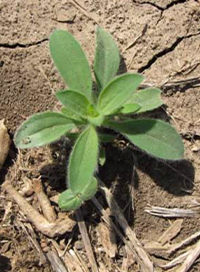 When spring rain events challenge timely herbicide applications before corn planting, agronomists and weed scientists say fall burndown treatments can help farmers manage those spring weeds.
When spring rain events challenge timely herbicide applications before corn planting, agronomists and weed scientists say fall burndown treatments can help farmers manage those spring weeds.
“For growers with kochia, marestail and winter annual weed issues, a burndown herbicide combination with residual would be best to help reduce spring populations,” says Gared Shaffer, South Dakota State University Extension Weeds Field Specialist. “Depending on the next cash crop, a producer can select from active ingredients like atrazine, flumioxazin, flumioxazin + pyroxasulfone, pyroxasulfone, s-metolachlor, acetochlor or a combination of these to match your weeds and environmental conditions.”
Kansas State University Extension Weed Specialist Sarah Lancaster cites henbit as one of many reasons why eastern Kansas growers use a fall-applied program. “Henbit and other weeds take soil moisture and other resources that we’d rather have for our cash crops.”
Spring Control Still Critical
Lancaster knows farmers have to strategically consider where they want to spend their weed control dollars in these challenging economic times. “When thinking about weed management, being proactive versus reactive to get a head start on weeds in the fall has its place. But it cannot be a substitute for a good residual program at planting time because the best time to kill weeds, especially pigweeds (waterhemp and Palmer) is before you see them,” she says.
For example, if you fall-apply and there’s a warm, wet winter, or you till the ground in the spring, that breaks up the herbicide barrier. Once you break up the herbicide barrier, you’re going to have a flush of weeds, she says. “Going into corn, we need a layered preemergent herbicide strategy to make sure there are no breaks in the barrier," Lancaster adds. "A start clean stay clean strategy is best because once we see weeds, they can get away from us fast, especially Palmer amaranth.”
Shaffer echoes that belief. “Because of the wet springs and the weed issues we’re having, weeds get out of control. Some of these fall herbicide options are only $6 to $7 per acre, which might save you a massive headache next spring if field conditions are unfavorable.”
Scout and Watch the Weather
Fall weed scouting from the combine to note where weed escapes have occurred is essential. Keeping track of where you see reduced weed control at harvest can tell you where to check for herbicide resistance issues. “It gives you an idea about how you might need to change up your herbicide selection or your weed management program in general,” Lancaster says.
Once you know your key weeds, tailor a herbicide mix for existing species size plus residual control. “It’s always best to spray during warmer temperatures when weeds are actively growing,” Shafer says. “Some herbicides like 2,4-D work better when daytime temps are in the 60s, while other products thrive in 40- and 50-degree temps, especially residual products that control perennials. Always refer to the herbicide labels for details on temperature, weed size, application rates, tank mix specifics, spray volume and nozzle use.”
Lancaster says winter weather tells the tale of potential spring weed control. “Once the ground freezes, soil microorganisms stop breaking the herbicides down,” she says. “After a cold, dry winter, you’ll see more residual herbicidal activity once the soils warm up. But a warmer, wetter winter will continue to break down the herbicide so there won’t be as much activity by spring. Either way, fall applications should be followed up with a residual herbicide at planting.”
Content provided by DTN/Progressive Farmer
The More You Grow
Find expert insights on agronomics, crop protection, farm operations and more.